Aprilia RSV MILLE User Manual 2002
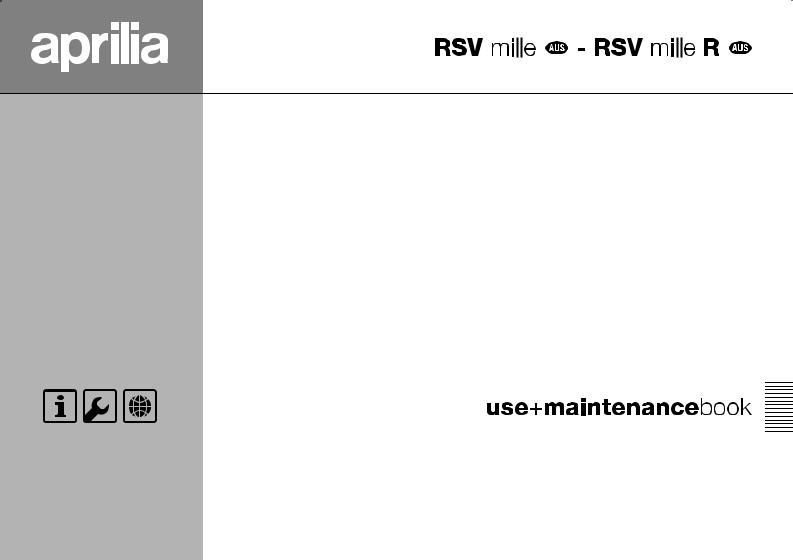






 8104561
8104561
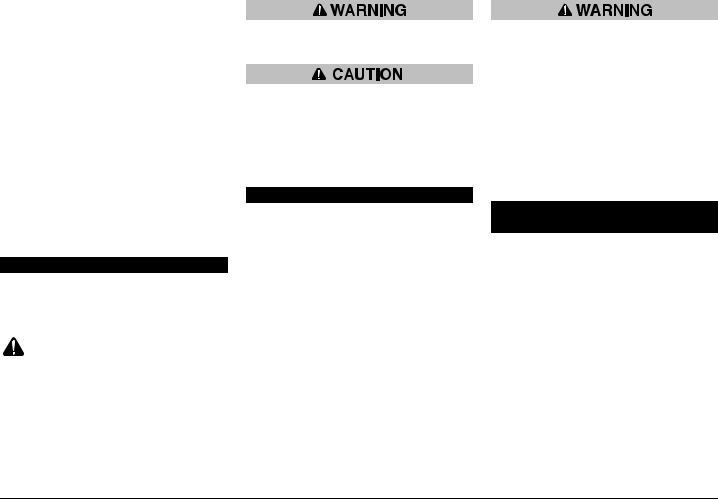
© 2002 aprilia s.p.a. - Noale (VE)
First edition: august 2002
Reprint:
Produced and printed by:
DECA s.n.c.
Via Risorgimento, 23/1 - Lugo (RA) - Italia
Tel. +39 - 0545 35235
Fax +39 - 0545 32844
E-mail: deca@decaweb.it
www.decaweb.it
On behalf of: aprilia s.p.a.
via G. Galilei, 1 - 30033 Noale (VE) - Italia Tel. +39 - 041 58 29 111
Fax +39 - 041 44 10 54 www.aprilia.com
SAFETY WARNINGS
The following precautionary warnings are used throughout this manual in order to convey the following messages:
Safety warning. When you find this symbol on the vehicle or in the manual, be careful to the potential risk of personal injury. Non-compliance with the indications given in the messages preceded by this symbol may result in grave risks for your and other
people’s safety and for the vehicle!
Indicates a potential hazard which may result in serious injury or even death.
Indicates a potential hazard which may result in minor personal injury or damage to the vehicle.
NOTE The word “NOTE” in this manual precedes important information or instructions.
TECHNICAL INFORMATION
The operations preceded by this
symbol must be repeated also on the opposite side of the vehicle.
If not expressly indicated otherwise, for the reassembly of the units repeat the disassembly operations in reverse order.
The terms “right” and “left” are referred to the rider seated on the vehicle in the normal riding position.
If the glove/tool kit compartment cover has been installed (as an alternative to the passenger seat), the transport of passenger, luggage or objects is forbidden.
The adjustments for the use of the vehicle on racetracks must be carried out exclusively in case of organized races or events that take place on isolated circuits, away from public roads and with the consent of the competent authorities.
It is strictly prohibited to carry out adjustments for the use of the vehicle on racetracks and then ride it on roads or motorways.
WARNINGS - PRECAUTIONS - GENERAL ADVICE
Before starting the engine, carefully read this manual and in particular the section “SAFE DRIVE”.
Your and other people’s safety depends not only on your quickness of reflexes and on your agility, but also on what you know about the vehicle, on its efficiency and on your knowledge of the basic information for “SAFE DRIVE”.
Therefore, get a thorough knowledge of the vehicle, in such a way as to be able to drive in the traffic safely.
2use and maintenance RSV mille !- RSV mille R !
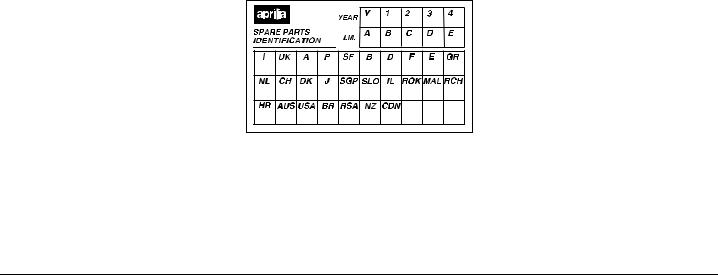
NOTE This manual must be considered as an integral part of the vehicle and must always accompany it, even in case of resale.
aprilia has carried out this manual with the maximum attention, in order to supply the user with correct and updated information. However, since aprilia constantly improves the design of its products, there may be slight discrepancies between the characteristics of your vehicle and those described in this manual.
For any clarification concerning the information contained in this manual, do not hesitate to contact your aprilia Official Dealer.
For control and repair operations not expressly described in this publication, for the purchase of aprilia genuine spare parts, accessories and other products, as well as for specific advice, contact exclusively aprilia Official Dealers and Service Centers, which guarantee prompt and accurate assistance.
Thank you for choosing aprilia. We wish you a nice ride.
All rights as to electronic storage, reproduction and total or partial adaptation, with any means, are reserved for all Countries.
NOTE In some countries the antipollution and noise regulations in force require periodical inspections.
The user of the vehicle in these countries must:
–contact an aprilia Official Dealer to have the non-homologated components replaced with others homologated for use in the country in question;
–carry out the required periodical inspections.
NOTE Soon after purchasing the vehicle, write down the identification data indicated on the SPARE PARTS IDENTIFICATION LABEL in the table here below. This label is positioned on the left side of the frame; to read it, it is necessary to remove the rider saddle, see p. 77 (REMOVING THE RIDER SADDLE).
These data indicate:
–YEAR = year of manufacture (Y, 1, 2, ...);
–I.M. = modification code (A, B, C, ...);
–COUNTRY CODES = homologation country (I, UK, A, ...).
and are to be supplied to the aprilia Official Dealer as reference data for the purchase of spare parts or specific accessories of the model you have acquired.
In this manual the various versions are indicated by the following symbols:
" RSV mille
# RSV mille R
$automatic light switching version (Automatic Switch-on Device)
% optional
& catalytic version
VERSION: |
|
|
' Italy |
( Singapore |
|
) United Kingdom * Slovenia |
||
+ Austria |
, Israel |
|
- Portugal |
. South Korea |
|
/ Finland |
0 Malaysia |
|
1 Belgium |
2 Chile |
|
3 Germany |
4 Croatia |
|
5 France |
! Australia |
|
6 Spain |
7 United States |
|
of America |
||
|
||
8 Greece |
9 Brazil |
|
: Holland |
; South Africa |
|
< Switzerland |
= New Zealand |
|
> Denmark |
? Canada |
|
@ Japan |
|
|
use and maintenance RSV mille !- RSV mille R ! 3

TABLE OF CONTENTS |
|
SAFE DRIVE ............................................................... |
5 |
BASIC SAFETY RULES ....................................... |
6 |
CLOTHING ........................................................... |
9 |
ACCESSORIES .................................................. |
10 |
LOAD .................................................................. |
10 |
ARRANGEMENT OF THE MAIN ELEMENTS ". 12 |
|
ARRANGEMENT OF THE MAIN ELEMENTS #. 14 |
|
ARRANGEMENT |
|
OF THE INSTRUMENTS/CONTROLS .................... |
16 |
INSTRUMENTS AND INDICATORS........................ |
17 |
INSTRUMENTS AND INDICATORS TABLE ...... |
18 |
MULTIFUNCTION COMPUTER ......................... |
20 |
MAIN INDEPENDENT CONTROLS......................... |
26 |
CONTROLS ON THE LEFT PART |
|
OF THE HANDLEBAR........................................ |
26 |
CONTROLS ON THE RIGHT PART |
|
OF THE HANDLEBAR........................................ |
27 |
IGNITION SWITCH ............................................. |
28 |
STEERING LOCK ............................................... |
28 |
AUXILIARY EQUIPMENT ........................................ |
29 |
UNLOCKING/LOCKING |
|
THE PASSENGER SEAT ................................... |
29 |
UNLOCKING/LOCKING |
|
THE GLOVE/TOOL KIT |
|
COMPARTMENT COVER .................................. |
30 |
GLOVE/TOOL KIT COMPARTMENT ................. |
31 |
LUGGAGE RACK FASTENINGS "................ |
31 |
SPECIAL TOOLS %......................................... |
32 |
ACCESSORIES .................................................. |
32 |
NUMBER PLATE-HOLDER EXTENSION %.... 32 |
|
MAIN COMPONENTS .............................................. |
33 |
FUEL................................................................... |
33 |
BRAKE FLUID - recommendations..................... |
34 |
DISC BRAKES .................................................... |
35 |
FRONT BRAKE .................................................. |
36 |
REAR BRAKE..................................................... |
37 |
CLUTCH FLUID - recommendations .................. |
38 |
CLUTCH ............................................................. |
39 |
COOLANT........................................................... |
40 |
TYRES ................................................................ |
42 |
ENGINE OIL ....................................................... |
43 |
ADJUSTING |
|
THE FRONT BRAKE CONTROL LEVER |
|
AND THE CLUTCH CONTROL LEVER ............. |
44 |
ADJUSTING |
|
THE REAR BRAKE CONTROL LEVER |
|
CLEARANCE ..................................................... |
44 |
ADJUSTING |
|
THE REAR BRAKE CONTROL LEVER |
|
AND THE GEAR LEVER ................................... |
45 |
AUTOMATIC LIGHT SWITCHING |
|
VERSION $..................................................... |
45 |
EXHAUST SILENCER/EXHAUST TERMINAL .. |
45 |
INSTRUCTIONS FOR USE ..................................... |
46 |
GETTING ON AND OFF THE VEHICLE ........... |
46 |
PRELIMINARY CHECKING OPERATIONS ...... |
48 |
PRELIMINARY CHECKING OPERATIONS ...... |
49 |
STARTING ......................................................... |
50 |
DEPARTURE AND DRIVE ................................ |
53 |
RUNNING-IN...................................................... |
56 |
STOPPING......................................................... |
57 |
PARKING ........................................................... |
57 |
POSITIONING THE VEHICLE ON THE STAND 58 |
|
SUGGESTIONS TO PREVENT THEFT ............ |
58 |
MAINTENANCE ...................................................... |
59 |
REGULAR SERVICE INTERVALS CHART....... |
60 |
IDENTIFICATION DATA .................................... |
62 |
JOINTS WITH CLICK CLAMPS |
|
AND WITH SCREW CLAMPS ........................... |
62 |
CHECKING |
|
THE ENGINE OIL LEVEL AND TOPPING UP .. |
62 |
CHANGING |
|
THE ENGINE OIL AND THE OIL FILTER ......... |
64 |
AIR CLEANER ................................................... |
66 |
ASSEMBLING THE PINS |
|
FOR THE REAR SUPPORT STAND %.......... |
67 |
POSITIONING THE VEHICLE |
|
ON THE REAR SUPPORT STAND %............. |
67 |
POSITIONING THE VEHICLE |
|
ON THE FRONT SUPPORT STAND %.......... |
67 |
FRONT WHEEL ................................................. |
68 |
FRONT BRAKE CALIPERS "....................... |
70 |
FRONT BRAKE CALIPERS #....................... |
71 |
REAR WHEEL ................................................... |
72 |
DRIVE CHAIN .................................................... |
75 |
REMOVING THE RIDER SADDLE.................... |
77 |
LIFTING THE FUEL TANK ................................ |
77 |
REMOVING THE SIDE FAIRINGS .................... |
78 |
REMOVING THE LOWER FAIRING.................. |
78 |
REMOVING THE SIDE COVERS...................... |
79 |
REMOVING THE REAR-VIEW MIRRORS |
........ 79 |
REMOVING THE FRONT PART |
|
OF THE FAIRING............................................... |
80 |
REMOVING THE SIDE STAND ......................... |
81 |
INSPECTING THE FRONT |
|
AND REAR SUSPENSIONS.............................. |
83 |
FRONT SUSPENSION ...................................... |
83 |
STEERING DAMPER......................................... |
86 |
REAR SUSPENSION......................................... |
87 |
CHECKING THE BRAKE PAD WEAR............... |
89 |
ADJUSTING |
|
THE COLD START CONTROL (A).................... |
90 |
IDLING ADJUSTMENT ...................................... |
90 |
ADJUSTING THE ACCELERATOR CONTROL 90 |
|
SPARK PLUGS .................................................. |
91 |
CHECKING THE SIDE STAND.......................... |
93 |
BATTERY........................................................... |
94 |
CHECKING AND CLEANING THE TERMINALS 94 |
|
REMOVING THE BATTERY .............................. |
95 |
CHECKING THE ELECTROLYTE LEVEL ......... |
96 |
RECHARGING THE BATTERY ......................... |
96 |
INSTALLING THE BATTERY............................. |
97 |
LONG INACTIVITY OF THE BATTERY............. |
98 |
CHECKING THE SWITCHES ............................ |
98 |
CHANGING THE FUSES................................... |
99 |
ADJUSTING |
|
THE VERTICAL HEADLIGHT BEAM............... |
101 |
BULBS.............................................................. |
102 |
CHANGING THE DASHBOARD BULBS ......... |
102 |
CHANGING THE HEADLIGHT BULBS ........... |
103 |
CHANGING THE FRONT |
|
AND REAR DIRECTION INDICATOR BULBS 105 |
|
CHANGING THE REAR LIGHT BULB............. |
106 |
TRANSPORT......................................................... |
107 |
CLEANING ............................................................ |
107 |
LONG PERIODS OF INACTIVITY ................... |
109 |
TECHNICAL DATA ............................................... |
110 |
LUBRICANT CHART........................................ |
114 |
Authorised Dealers and Service Centres ......... |
115 |
Importers ................................................... |
116 -117 |
WIRING DIAGRAM - |
|
RSV mille - RSV mille R ................................... |
118 |
WIRING DIAGRAM - |
|
RSV mille $- RSV mille R $...................... |
120 |
4use and maintenance RSV mille !- RSV mille R !
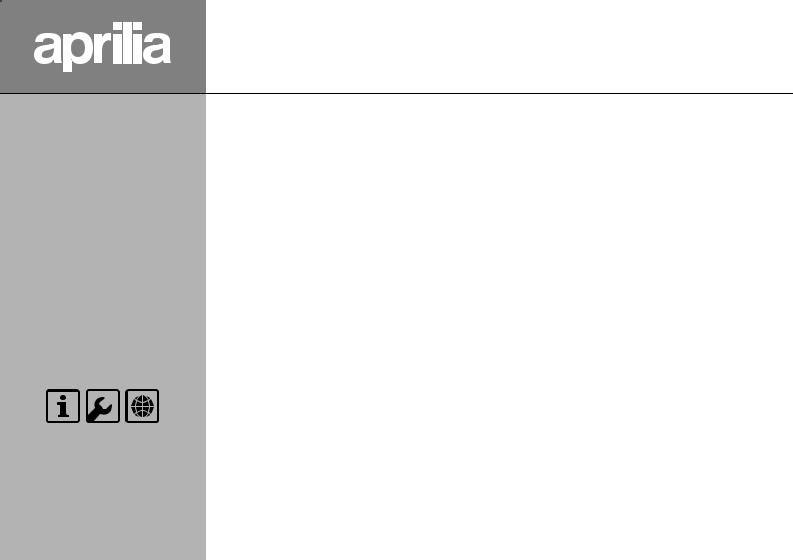
safe drive
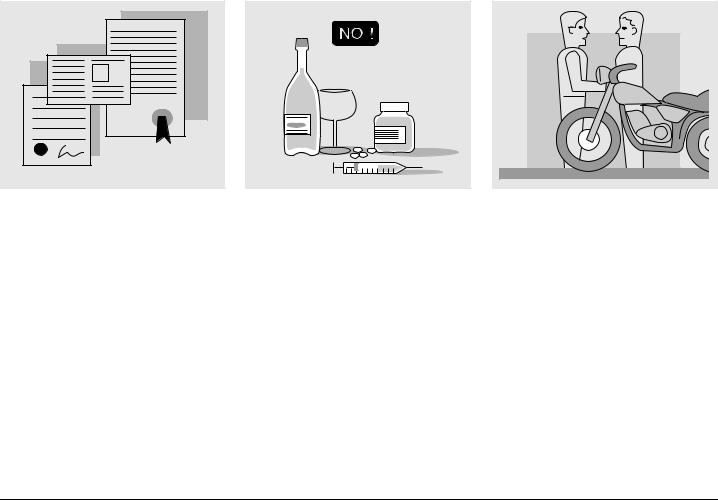
BASIC SAFETY RULES
To drive the vehicle it is necessary to be in possession of all the requirements prescribed by law (driving licence, minimum age, psychophysical ability, insurance, state taxes, vehicle registration, number plate, etc.).
Gradually get to know the vehicle by driving it first in areas with low traffic and/or private areas.
The use of medicins, alcohol and drugs or psychotropic substances notably increases the risk of accidents.
Be sure that you are in good psychophysical conditions and fit for driving and pay particular attention to physical weariness and drowsiness.
Most road accidents are caused by the driver’s lack of experience.
NEVER lend the vehicle to beginners and, in any case, make sure that the driver has all the requirements for driving.
6use and maintenance RSV mille !- RSV mille R !
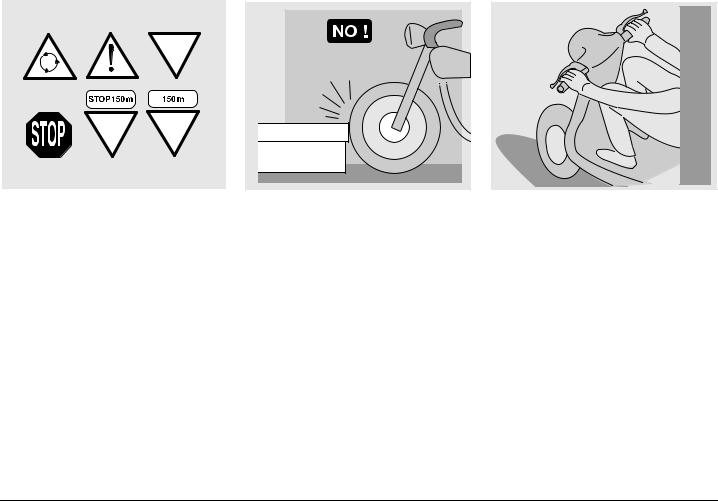
Rigorously observe all road signs and national and local road regulations.
Avoid abrupt movements that can be dangerous for yourself and other people (for example: rearing up on the back wheel, speeding, etc.), and give due consideration to the road surface, visibility and other driving conditions.
Avoid obstacles that could damage the vehicle or make you lose control.
Avoid riding in the slipstream created by preceding vehicles in order to increase your speed.
Always drive with both hands on the handlebars and both feet on the footrests (or on the rider’s footboards), in the correct driving posture.
Avoid standing up or stretching your limbs while driving.
use and maintenance RSV mille !- RSV mille R ! |
7 |
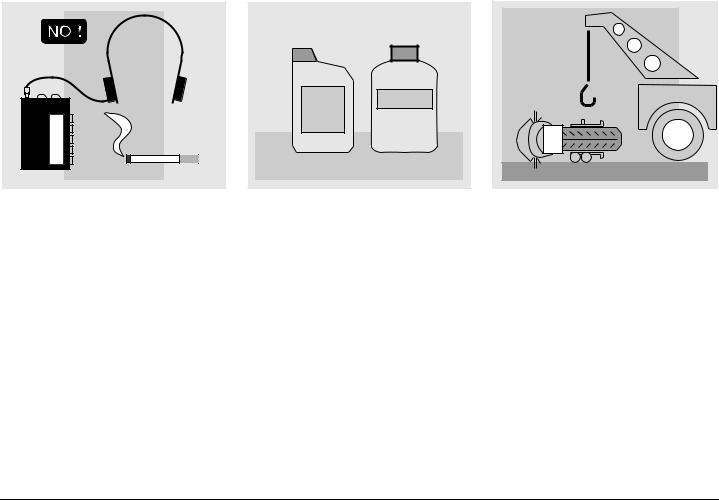
The driver should pay attention and avoid distractions caused by people, things and movements (never smoke, eat, drink, read, etc.) while driving.
COOLER |
OIL |
Use only the vehicle’s specific fuels and lubricants indicated in the "LUBRICANT CHART"; check all oil, fuel and coolant levels regularly.
If the vehicle has been involved in an accident, make sure that no damage has occurred to the control levers, pipes, wires, braking system and vital parts.
If necessary, have the vehicle inspected by an aprilia Official Dealer who should carefully check the frame, handlebars, suspensions, safety parts and all the devices that you cannot check by yourself.
Always remember to report any malfunction to the technicians to help them in their work.
Never use the vehicle when the amount of damage it has suffered endangers your safety.
8use and maintenance RSV mille !- RSV mille R !
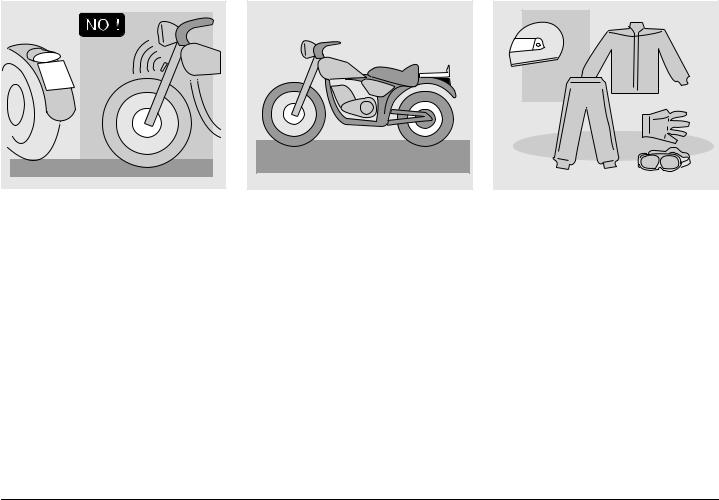
A12 |
345 |
Never change the position, inclination or colour of: number plate, direction indicators, lights and horns.
Any modification of the vehicle will result in the invalidity of the guarantee
ONLY ORIGINALS
Any modification of the vehicle and/or the removal of original components can compromise vehicle performance levels and safety or even make it illegal.
We recommend respecting all regulations and national and local provisions regarding the equipment of the vehicle.
In particular, avoid all modifications that increase the vehicle’s performance levels or alter its original characteristics.
Never race with other vehicles.
Avoid off-road driving.
CLOTHING |
Before starting, always wear a correctly fastened crash helmet. Make sure that it is homologated, in good shape, of the right size and that the visor is clean.
Wear protective clothing, preferably in light and/or reflecting colours. In this way you will make yourself more visible to the other drivers, thus notably reducing the risk of being knocked down, and you will be more protected in case of fall.
This clothing should be very tight-fitting and fastened at the wrists and ankles; strings, belts and ties should not be hanging loose; prevent these and other objects from interfering with driving by getting entangled with moving parts or driving mechanisms.
use and maintenance RSV mille !- RSV mille R ! |
9 |
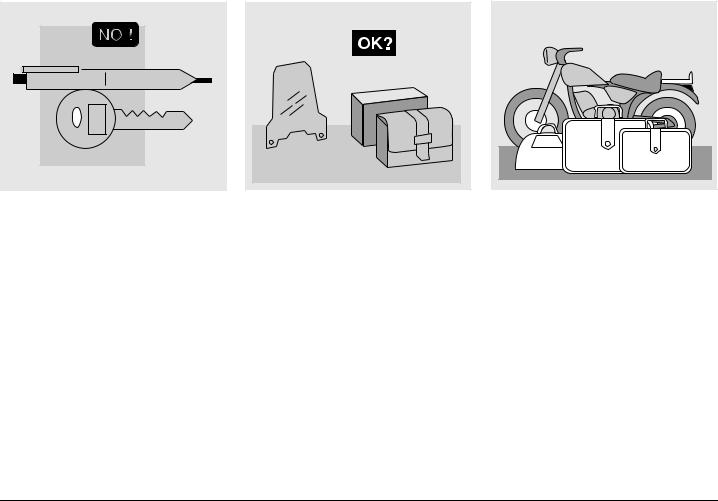
Do not keep objects that can be dangerous in case of fall, for example pointed objects like keys, pens, glass vials etc. in your pockets (the same recommendations also apply to passengers).
ACCESSORIES
The owner of the vehicle is responsible for the choice, installation and use of any accessory.
Avoid installing accessories that cover horns or lights or that could impair their functions, limit the suspension stroke and the steering angle, hamper the operation of the controls and reduce the distance from the ground and the angle of inclination in turns.
Avoid using accessories that hamper access to the controls, since this can prolong reaction times during an emergency.
Big fairings and windshields installed on the vehicle may produce aerodynamic forces that affect the stability of the vehicle, especially when riding at high speed.
Make sure that the equipment is well fastened to the vehicle and not dangerous during driving.
Do not install electrical devices and do not modify those already existing to avoid electrical overloads, because the vehicle could suddenly stop or there could be a dangerous current shortage in the horn and in the lights.
aprilia recommends the use of genuine accessories (aprilia genuine accessories).
LOAD
Be careful and moderate when loading your luggage. Keep any luggage loaded as close as possible to the center of gravity of the vehicle and distribute the load uniformly on both sides, in order to reduce umbalance to the minimum. Furthermore, make sure that the load is firmly secured to the vehicle, especially during long trips.
Avoid hanging bulky, heavy and/or danger-
10 use and maintenance RSV mille !- RSV mille R !
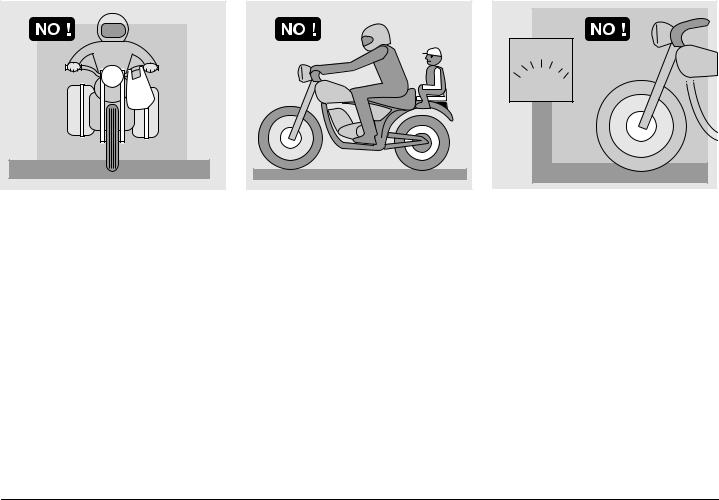
KG! |
ous objects on the handlebars, mudguards and forks, because the vehicle might respond more slowly in turns and its manoeuvrability could be unavoidably impaired.
Do not place bags that are too bulky on the vehicle sides and do not ride with the crash helmet, because they could hit people or obstacles, making you lose control of the vehicle.
Do not carry any bag if it is not tightly secured to the vehicle.
Do not carry bags which protrude too much from the luggage-rack or which cover the lights, horn or indicators.
Do not carry animals or children on the glove compartment or on the luggage rack.
Do not exceed the maximum load allowed for each side-bag.
When the vehicle is overloaded, its stability and its manoeuvrability can be compromised.
use and maintenance RSV mille !- RSV mille R ! 11
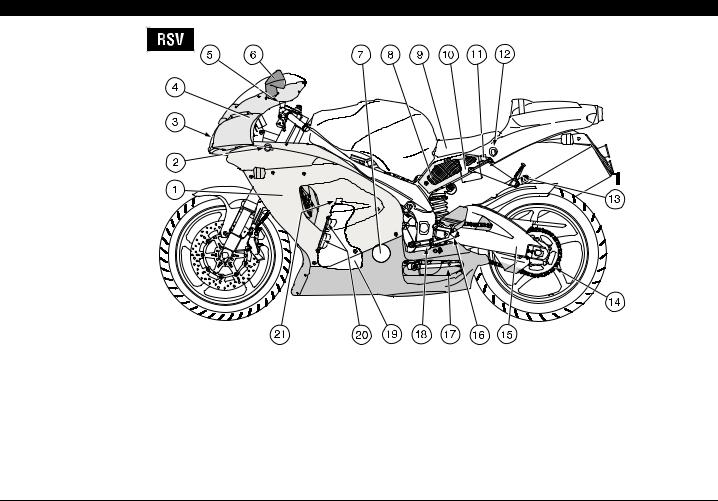
ARRANGEMENT OF THE MAIN ELEMENTS "
|
|
|
|
|
|
|
|
|
|
|
|
|
|
|
|
|
|
|
|
|
|
|
|
KEY |
|
|
|
|
|
|
|
|
|||
1) |
Left fairing |
6) |
Left rear-view mirror |
13) |
Passenger left footrest |
19) |
Engine oil tank |
||||
2) Non-adjustable steering |
7) |
Engine oil filter |
|
(snapping, closed/open) |
20) |
Engine oil level |
|||||
|
damper (adjustable steering |
8) |
Left side cover |
14) |
Drive chain |
21) |
Engine oil tank cap |
||||
|
damper "%) |
9) |
Rider saddle |
15) |
Rear fork |
|
|
|
|||
3) |
Headlight |
10) |
Battery |
16) |
Rider left footrest |
|
|
|
|||
4) |
Front part of the fairing |
11) |
Main fuse carrier (30 A) |
17) |
Side stand |
|
|
|
|||
5) |
Clutch fluid reservoir |
12) |
Passenger seat lock |
18) |
Shifting lever |
|
|
|
|||
12 use and maintenance RSV mille !- RSV mille R !
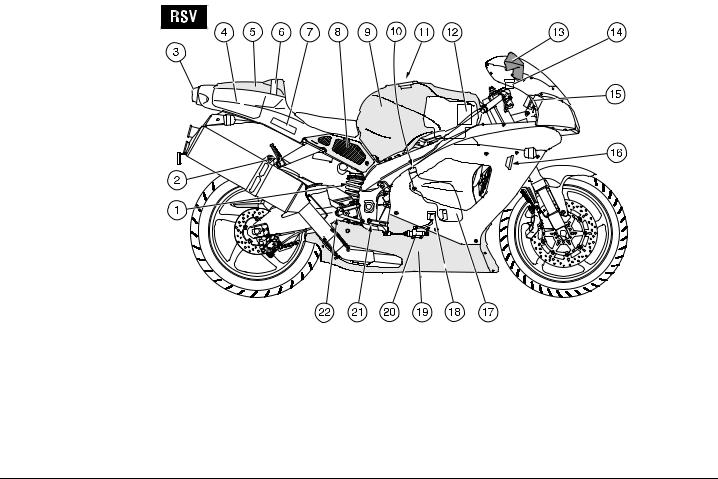
|
|
|
|
|
|
|
|
|
|
|
|
|
|
|
|
|
|
|
|
|
|
|
|
|
|
|
|
|
|
|
|
|
|
|
|
|
|
|
|
|
|
|
|
|
|
|
|
|
|
|
|
|
|
|
|
|
|
|
|
|
|
|
|
|
|
|
|
|
|
|
|
|
|
|
|
|
|
|
|
|
|
|
|
|
|
|
|
|
|
|
|
|
|
|
|
|
|
|
|
|
|
|
|
|
|
|
|
|
|
|
|
|
|
|
|
|
|
|
|
|
|
|
|
|
|
|
|
|
|
|
|
|
|
|
KEY |
|
|
|
|
|
|
|
|
|
|
|
|
||
1) |
Rear shock absorber |
6) |
Passenger grab strap |
13) |
Right rear-view mirror |
19) |
Lower fairing |
|||||||
2) |
Passenger right footrest |
7) |
Electronic unit |
14) |
Front brake fluid tank |
20) |
Rear brake pump |
|||||||
|
(snapping, closed/open) |
8) |
Right side cover |
15) |
Secondary fuse carrier |
21) |
Rear brake control lever |
|||||||
3) |
Rear light |
9) |
Fuel tank |
|
(15 A) |
22) |
Rider right footrest |
|||||||
4) |
Glove/tool kit compartment |
10) Coolant expansion tank cap |
16) |
Horn |
|
|
|
|||||||
5) |
Passenger seat (glove/tool kit |
11) Fuel tank filler cap |
17) |
Expansion tank |
|
|
|
|||||||
|
compartment cover) |
12) Air cleaner |
18) |
Rear brake fluid tank |
|
|
|
|||||||
use and maintenance RSV mille !- RSV mille R ! 13
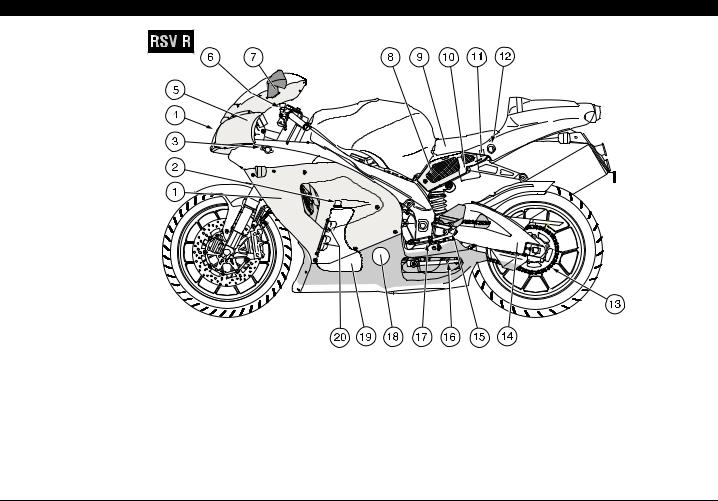
ARRANGEMENT OF THE MAIN ELEMENTS #
|
|
|
|
|
|
|
|
|
|
|
|
|
|
|
|
|
|
|
|
|
|
|
|
KEY |
|
|
|
|
|
|
|
|
|||
1) |
Left fairing |
8) |
Left side cover |
13) |
Drive chain |
18) |
Engine oil filter |
||||
2) |
Engine oil tank cap |
9) |
Rider saddle |
14) |
Rear fork |
19) |
Engine oil tank |
||||
3) |
Adjustable steering damper |
10) |
Battery |
15) |
Rider left footrest |
20) |
Engine oil level |
||||
4) |
Headlight |
11) |
Main fuse carrier (30A) |
16) |
Side stand |
|
|
|
|||
5) |
Front part of the fairing |
12) |
Glove/tool kit compartment |
17) |
Shifting lever |
|
|
|
|||
6) |
Clutch fluid reservoir |
|
|
lock |
|
|
|
|
|
||
7) |
Left rear-view mirror |
|
|
|
|
|
|
|
|
||
14 use and maintenance RSV mille !- RSV mille R !
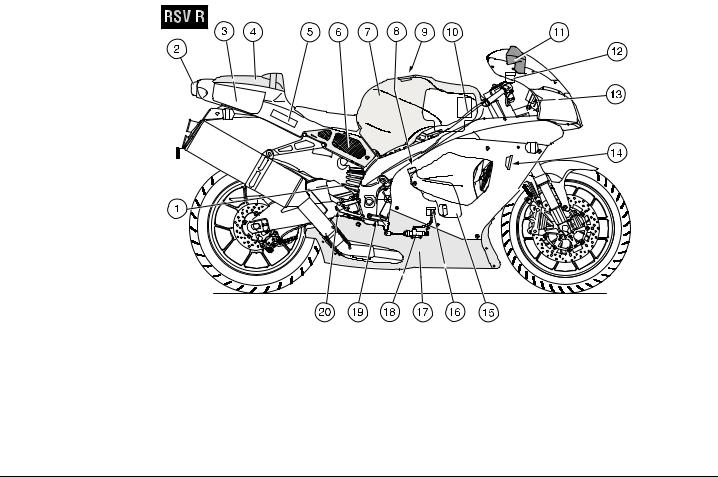
|
|
|
|
|
|
|
|
|
|
|
|
|
|
|
|
|
|
|
|
|
|
|
|
|
|
|
|
|
|
|
|
|
|
|
|
|
|
|
|
|
|
|
|
|
|
|
|
|
|
|
|
|
|
|
|
|
|
|
|
|
|
|
|
|
|
|
|
|
|
|
|
|
|
|
|
|
|
|
|
|
|
|
|
|
|
|
|
|
|
|
|
|
|
|
|
|
|
|
|
|
|
|
|
|
|
|
|
|
|
|
|
|
|
|
|
|
|
|
|
|
|
|
|
|
|
|
|
|
|
|
|
|
|
|
|
|
|
|
|
KEY |
|
|
|
|
|
|
|
|
|
|
|
|
|
1) |
Rear shock absorber |
7) |
Fuel tank |
13) |
Secondary fuse carrier |
19) |
Rear brake control lever |
||||||
2) |
Rear light |
8) |
|
Coolant expansion tank |
|
(15A) |
20) |
Rider right footrest |
|||||
3) |
Glove/tool kit compartment |
|
|
cap |
14) |
Horn |
|
|
|
||||
4) |
Glove/tool kit compartment |
9) |
Fuel tank filler cap |
15) |
Expansion tank |
|
|
|
|||||
|
cover |
10) |
Air cleaner |
16) |
Rear brake fluid tank |
|
|
|
|||||
5) |
Electronic unit |
11) |
Right rear-view mirror |
17) |
Lower fairing |
|
|
|
|||||
6) |
Right side cover |
12) |
Front brake fluid tank |
18) |
Rear brake pump |
|
|
|
|||||
use and maintenance RSV mille !- RSV mille R ! 15
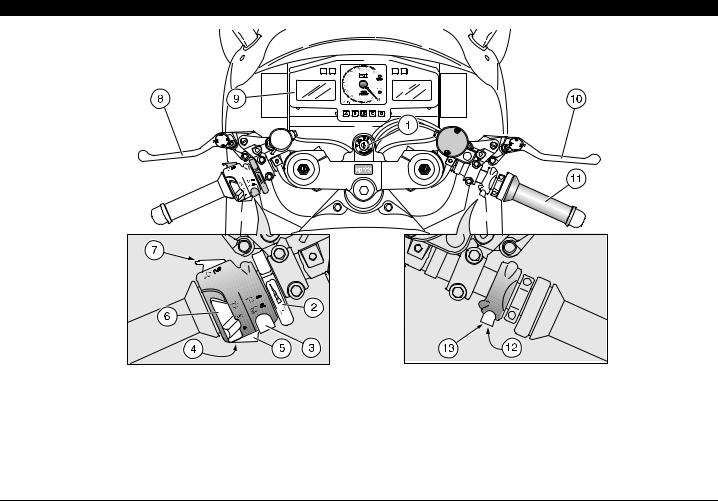
ARRANGEMENT OF THE INSTRUMENTS/CONTROLS
|
|
|
|
|
|
|
|
|
|
|
|
|
|
|
|
|
|
|
|
|
|
|
|
|
|
|
|
|
|
|
|
|
|
|
|
|
|
|
|
|
|
|
|
|
|
|
|
|
|
|
|
|
|
|
|
|
|
|
|
|
|
|
|
|
|
|
|
|
|
|
|
|
|
|
|
|
|
|
|
|
|
|
|
|
|
|
|
|
|
|
|
|
|
|
|
|
|
|
|
|
|
|
|
|
|
|
|
|
|
|
|
|
|
|
|
|
|
|
|
|
|
|
|
|
|
|
|
|
|
|
|
|
|
|
|
|
|
|
|
|
|
|
|
|
|
|
|
|
|
|
|
|
|
|
|
|
|
|
|
|
|
|
|
|
KEY |
|
|
|
|
|
|
|
|
|
|
|
|
||
1) |
Ignition switch/steering lock (B- C- D) |
8) |
Clutch lever |
|||||||||||
2) |
Cold start lever (A) |
9) |
Instruments and indicators |
|||||||||||
3) |
Dimmer switch (E- F) |
10) |
Front brake lever |
|||||||||||
4) |
Direction indicator switch (G) |
11) |
Throttle grip |
|||||||||||
5) |
Horn push button (H) |
12) |
Start push button (K) |
|||||||||||
6) |
Light switch (I- J- •) (not provided for $) |
13) |
Engine stop switch (LBMC) |
|||||||||||
7)High beam signaller push button (F)/LAP push button (multifunction)
16 use and maintenance RSV mille !- RSV mille R !
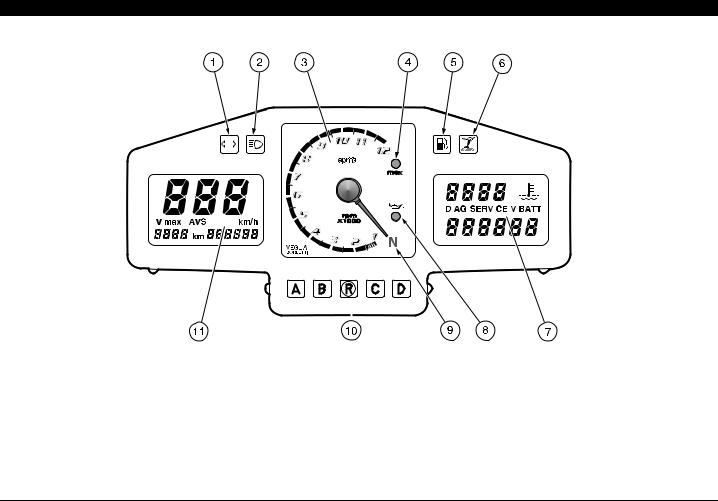
INSTRUMENTS AND INDICATORS
|
|
|
|
|
|
|
|
|
|
|
|
|
|
|
|
|
|
|
|
|
|
|
|
|
|
|
|
|
|
|
|
|
|
|
|
|
|
|
|
|
|
|
|
|
|
|
|
|
|
|
|
|
|
|
|
|
|
|
|
|
|
|
|
|
|
|
|
|
|
|
|
|
|
|
|
|
|
|
|
|
|
|
|
|
|
|
|
|
|
|
|
|
|
|
|
|
|
|
|
|
|
|
|
|
|
|
|
|
|
|
|
|
|
|
|
|
|
|
|
|
|
|
|
|
|
|
|
|
|
|
|
|
|
|
|
|
|
|
|
|
|
|
|
|
|
|
|
|
|
|
|
|
|
|
|
|
|
|
|
|
|
|
|
|
|
|
|
|
|
|
|
|
|
|
|
|
|
|
|
|
|
|
|
|
|
|
|
|
|
|
|
|
|
|
|
|
|
|
|
|
|
|
|
|
|
|
|
|
|
|
|
|
|
|
|
|
|
|
|
|
|
|
|
|
|
|
|
|
|
|
|
|
|
|
|
|
|
|
|
|
|
|
|
|
|
|
|
|
|
|
|
|
|
|
|
|
|
|
|
|
|
|
|
|
|
|
|
|
|
|
|
|
|
|
|
|
|
|
|
|
|
|
|
|
|
|
|
|
|
|
|
|
|
|
|
|
|
|
|
|
|
|
|
|
|
|
|
|
|
|
|
|
|
|
|
|
|
|
|
|
|
|
|
|
|
|
|
|
|
|
|
|
|
|
|
|
|
|
|
|
|
|
|
|
|
|
|
|
|
|
|
|
|
|
|
|
|
|
|
|
|
|
|
|
|
|
|
|
|
|
|
|
|
|
|
|
|
|
|
|
|
|
|
|
|
|
|
|
|
|
|
|
|
|
|
|
|
|
|
|
|
|
|
|
|
|
|
|
|
|
|
|
|
|
|
|
|
|
|
|
|
|
|
|
|
|
|
|
|
|
|
|
|
|
|
|
|
|
|
|
|
|
|
|
|
|
|
|
|
|
|
|
|
|
|
|
|
|
|
|
|
|
|
|
|
|
|
|
|
|
|
|
|
|
|
|
|
|
|
|
|
|
|
|
|
|
|
|
|
|
|
|
|
|
|
|
|
|
|
|
|
|
|
|
|
|
|
|
|
|
|
|
|
|
|
|
|
|
|
|
|
|
|
|
|
|
|
|
|
|
|
|
|
|
|
|
|
|
|
|
|
|
|
|
|
|
|
|
|
|
|
|
|
|
|
|
|
|
|
|
|
|
|
|
|
|
|
|
|
|
|
|
|
|
|
|
|
|
|
|
|
|
|
|
|
|
|
|
|
|
|
|
|
|
|
|
|
|
|
|
|
|
|
|
|
|
|
|
|
|
|
|
|
|
|
|
|
|
|
|
|
|
|
|
|
|
KEY |
|
|
|
|
|
|
|
|
|
|
|
|
|
|||||
1) |
Green direction indicator warning light (G) |
7) |
Right multifunction digital display (coolant temperature - clock |
|||||||||||||||
2) |
Blue high beam warning light (F) |
|
|
|
|
|
- battery voltage - chronometer - diagnostic) |
|||||||||||
3) |
Revolution counter |
8) |
Red engine oil pressure warning light LED (P) |
|||||||||||||||
4) |
Programmable red line warning light LED (max) |
9) |
Green neutral indicator warning light (Q) |
|||||||||||||||
5) |
Amber low fuel warning light (N) |
10) |
Multifunction computer programming push buttons |
|||||||||||||||
6) |
Amber “side stand down” warning light (O) |
11) |
Left multifunction digital display (speedometer - odometer) |
|||||||||||||||
use and maintenance RSV mille !- RSV mille R ! 17
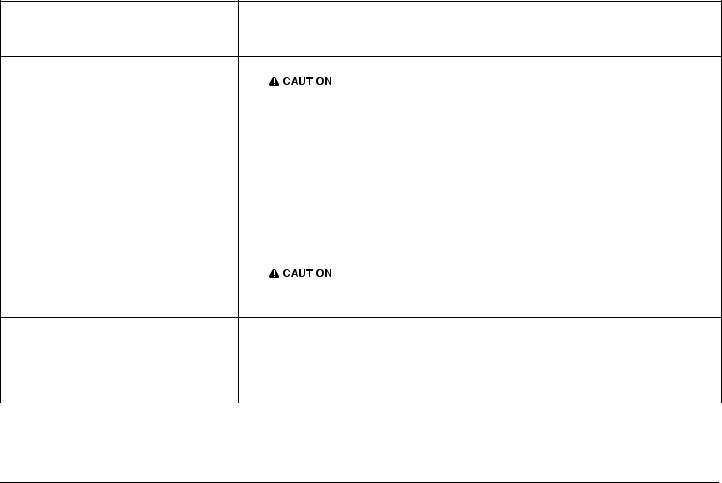
INSTRUMENTS AND INDICATORS TABLE
Description |
Function |
Direction indicator warning light |
G Blinks when the direction indicators are on. |
|
|
High beam warning light |
F Comes on when the high beam bulbs are on or when the headlight signaller is operated. |
Indicates the number of revolutions of the engine per minute.
Revolution counter rpm |
|
|
|
Never exceed the engine max. speed rate, see p. 56 (RUNNING- |
|
|
|
|
IN). |
|
|
|
|
|
|
|
|
|
|
|
|
Blinks when the max. rpm set by the user is reached, see p. 22 [SETTING THE RED LINE |
||
|
|
THRESHOLD (WITH ENGINE OFF ONLY)]. |
||
Red line warning light LED |
max It comes on when the engine max. rpm threshold setting is confirmed, see p. 22 [SETTING THE |
|||
|
|
RED LINE THRESHOLD (WITH ENGINE OFF ONLY)] and whenever the ignition key is rotated |
||
|
|
to position “B”, for about three seconds, see p. 20 (MULTIFUNCTION COMPUTER). |
||
|
|
|
|
|
Low fuel warning light |
N |
Comes on when the quantity of fuel left in the tank is about 4.5 ± 1 !. |
||
|
|
In this case, top up as soon as possible, see p. 33 (FUEL). |
||
Side stand down warning light |
O Comes on when the side stand is down. |
|||
|
|
|
|
|
|
|
Comes on whenever the ignition switch is in position “B” and the engine is not running, thus |
||
|
|
checking the functionality of the LED. |
||
Engine oil pressure warning light |
P |
If the light LED does not come on in this phase, contact an aprilia Official Dealer. |
||
|
|
If the engine oil pressure warning light LED “P” remains on after |
||
|
|
|||
LED |
|
|
||
|
|
|
|
the start or comes on during the normal operation of the engine, |
|
|
|
|
|
|
|
this means that the engine oil pressure in the circuit is insufficient. |
||
In this case, stop the engine immediately and contact an aprilia Official Dealer.
Neutral indicator warning light |
Q Comes on when the gear is in neutral. |
|
|
|
|
|
|
Multifunction |
Speedometer (km/h) |
Indicates the instantaneous, average or maximum driving speed. |
To alternate the |
|
|
data displayed, |
|
|
|
||
digital display |
Odometer (km) |
Indicates the partial or total number of kilometres covered. |
see p. 20 (MUL- |
(left side) |
T I F U N C T I O N |
||
|
|
|
COMPUTER). |
|
|
|
|
18 use and maintenance RSV mille !- RSV mille R !
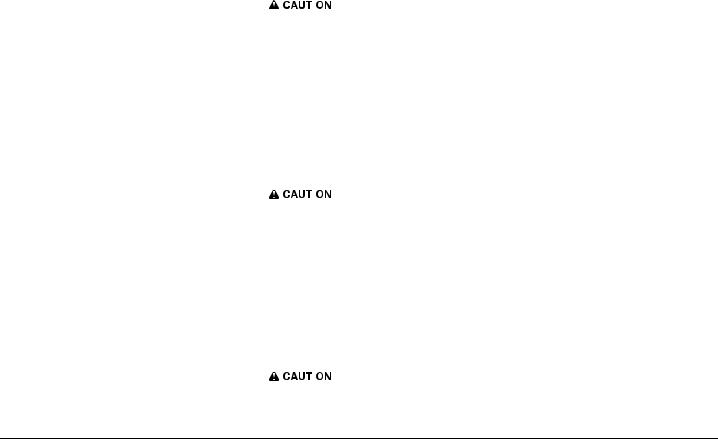
Description |
|
Function |
|
||||
|
|
|
Indicates the temperature of the coolant in the engine, see p. 20 (MULTI- |
|
|||
|
|
|
FUNCTION COMPUTER). |
|
|||
|
|
|
|
|
|
Do not leave the ignition switch in position “C”, |
|
|
|
|
|
|
|
|
|
|
|
|
|
|
|
|
|
|
|
|
|
|
|
since the cooling fans would stop independently |
|
|
|
|
|
|
|
|
|
|
|
|
of the coolant temperature; in this case there would be a further temper- |
|
|||
|
|
|
ature increase. |
|
|||
|
|
|
If a temperature of 115 – 120 °C (239 – 248 °F) is displayed, stop the engine, |
|
|||
|
|
|
turn the ignition key to position “B” and wait for the disconnection of the cool- |
|
|||
|
C o o l a n t t e m p e r a - |
|
ing fans. |
|
|||
|
R |
At this point turn the ignition key to position “C” and check the coolant level, |
|
||||
|
ture (°C/°F) |
|
see p. 40 (COOLANT). |
|
|||
|
|
|
If the writing "LLL" is displayed, stop the vehicle and let the engine run at 3000 |
To alternate the |
|||
|
|
|
rpm for approximately two minutes, thus allowing the coolant to circulate reg- |
||||
|
|
|
ularly in the system; then press the engine stop switch to position "MC" and |
data displayed, |
|||
|
|
|
check the coolant level, see p. 40 (COOLANT). If the writing “LLL” is still dis- |
see p. 20 (MUL- |
|||
|
|
|
played after the coolant level has been checked, contact an aprilia Official |
TIFUNCTION |
|||
Multifunction |
|
|
Dealer. |
COMPUTER). |
|||
|
|
|
|
|
|
|
|
digital display |
|
|
|
|
|
If the maximum allowed temperature (120°C - |
|
|
|
|
|
|
|
||
(right side) |
|
|
|
|
|
248 °F) is exceeded, the engine may be serious- |
|
|
|
|
|
|
|
||
|
|
|
ly damaged. |
|
|||
|
|
|
|
|
|
|
|
|
Clock |
|
Indicates the hour and minutes according to the presetting, see p. 20 (MULTI- |
|
|||
|
|
FUNCTION COMPUTER). |
|
||||
|
|
|
|
||||
|
|
|
|
|
|
|
|
|
Battery voltage V |
|
Indicates the battery voltage, see p. 20 (MULTIFUNCTION COMPUTER). |
|
|||
|
BATT |
|
|
||||
|
|
|
|
|
|
|
|
|
|
|
|
|
|
|
|
|
Chronometer |
|
Indicates the various timings according to the presetting, see p. 20 (MULTI- |
|
|||
|
|
FUNCTION COMPUTER). |
|
||||
|
|
|
|
||||
|
|
|
|
|
|
|
|
|
|
|
Whenever the ignition switch is brought to position “B”, the writing "efi" appears on the right |
||||
|
|
|
side of the multifunction display for approximately three seconds. |
|
|||
|
Diagnostics |
|
|
|
|
If the writing “EFI” is displayed during the normal operation of the |
|
|
|
|
|
|
|||
|
|
|
|
|
|||
|
|
|
|
|
|
engine, this means that the electronic unit has detected an anoma- |
|
|
|
|
|
|
|
||
|
|
|
ly. In many cases, the engine keeps running with reduced performance levels; immedi- |
||||
|
|
|
ately contact an aprilia Official Dealer. |
|
|||
|
|
|
|
|
|
|
|
use and maintenance RSV mille !- RSV mille R ! 19
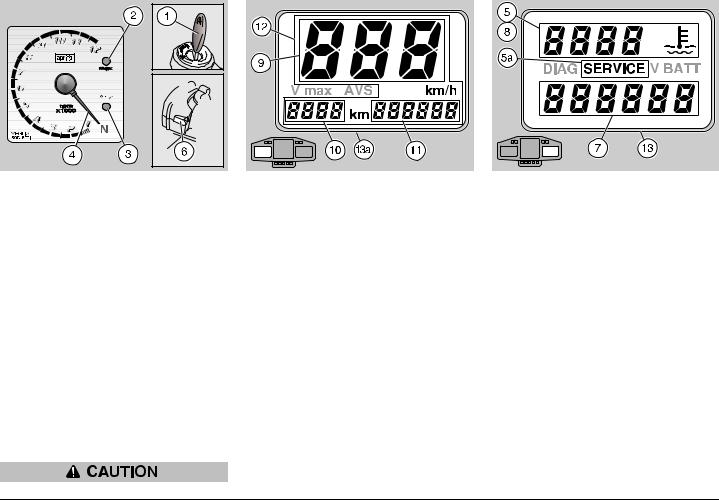
MULTIFUNCTION COMPUTER
When the ignition key (1) is rotated to position “B”, the following warning lights come on on the dashboard:
–red line warning light LED “max” (2);
–red engine oil pressure warning light
LED “P” (3), which remains on until the engine starts.
The pointer (4) of the revolution counter shifts to the maximum value (rpm) set by the user. After about three seconds the red line warning light LED "max" (2) goes off; the pointer (4) of the revolution counter returns to its initial position.
The writing "EFI" (5) appears on the right side of the multifunction display for three seconds.
In this way the component operation is tested.
After the first 1000 km and successively
every 7500 km, the writing “SERVICE” (5a) appears on the right display.
In this case contact an aprilia Official Dealer, who will carry out the operations indicated in the regular service intervals chart, see p. 60 (REGULAR SERVICE INTERVALS CHART). To make the writing “SERVICE” disappear, press the “LAP” push button (6) and then the push button S and keep them pressed for about five seconds.
With the ignition key (1) in position "B" the standard settings on the dashboard are the following:
Right display: Clock (7), coolant temperature in °C (8).
Left display: Instantaneous speed in km/h (9), trip 1 (trip odometer) (10), total kilometres/ odometer (11).
Upon installation of the battery or of the 30A main fuses:
–the revolution counter pointer (4) makes twelve clockwise clicks, thus checking the operation of the revolution counter itself;
–the instantaneous, maximum and average speed function is set in “km/h”;
–the coolant temperature is set in °C;
–the digital clock is set to zero;
–the red line is set at 6000 rpm, indicated by the coming on of the red line warning light LED “max ” (red) (2).
NOTE If necessary, carry out the appropriate adjustments.
SEGMENT OPERATION CHECK
Press the push buttons T and U at the same time.
Rotate the ignition key (1) from position “C” to position “B”.
All the segments (13) (13a) will remain on until the push buttons T and U are released.
20 use and maintenance RSV mille !- RSV mille R !
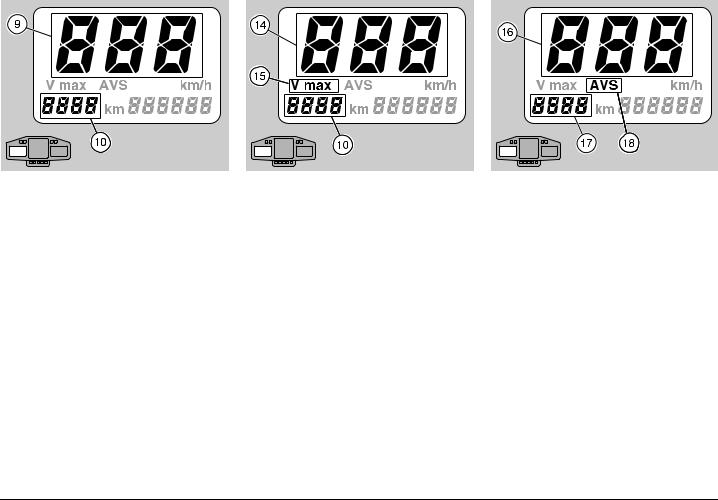
SETTING THE INSTANTANEOUS, MAXIMUM AND AVERAGE SPEED (LEFT DISPLAY)
NOTE Two seconds after the vehicle has started moving, the instantaneous speed is automatically shown on the display, even if a different function is set.
When the ignition key is rotated to position “B”, the instantaneous speed (9) and the partial number of kilometres covered “trip 1” (10) appear on the left display.
Resetting “trip 1” (10): with the odometer set on the instantaneous speed function, press the push button Sfor about two seconds.
To display the maximum speed (14) and
the distance “trip 1” (10), press the push button U for about one second. The writing “V max” (15), the maximum speed (14) and the distance “trip 1” (10) are displayed.
Resetting the maximum speed (14): with the odometer set on the “V max” function, press the push button S for about 2 seconds.
NOTE The measurement of the maximum speed is relevant to the distance covered from the last setting to zero of the maximum speed itself. The distance “trip 1” (10) shown on the display indicates the number of kilometres covered from the last setting to zero, to the distance “trip 1”.
To display the average speed (16) and
the distance “trip 2” (17), press the push button Uagain for about 1 second.
The writing “AVS” (18), the average speed (16) and the distance “trip 2” (17) are displayed.
Resetting the average speed (16) and the distance “trip 2” (17): with the odometer set on the “AVS” function, press the push button Sfor about 1 second.
NOTE The measurement of the average speed is relevant to the distance “trip 2” (odometer).
The distance “trip 2” (17) shown on the display indicates the number of kilometres covered from the last setting to zero.
If more than 1000 km are covered without setting “trip 2” to zero, the value of the average speed will be wrong.
To display the instantaneous speed (13)
and the distance “trip 1” (10), press the push button Uagain.
use and maintenance RSV mille !- RSV mille R ! 21
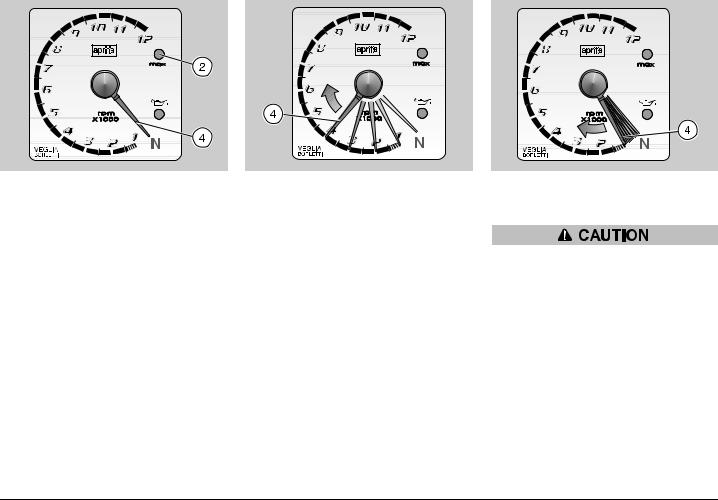
SETTING THE RED LINE THRESHOLD (WITH ENGINE OFF ONLY)
When the maximum rpm set is exceeded, the red line warning light LED “max”
(2) positioned on the dashboard starts blinking.
If the push button V is pressed for less than one second, the pointer of the revolution counter (4) shifts to the red line value set for three seconds, after which it returns to its initial position.
For the adjustment, proceed as follows:
Press the push button V, release it and press it V again within 3 seconds. The
pointer (4) moves increasing the value by 1000 rpm at each click, as long as V is kept pressed; when it has reached the maximum value, it starts again from the beginning.
Press the push button V until the desired rpm value has been set.
If the push button Vis released and then pressed again within 3 seconds, intermittently, the pointer (4) moves increasing the value by 100 rpm at each click; when it has reached the maximum value, it starts again from the beginning.
NOTE It is not possible to set the red line at values lower than 2000 rpm or higher than 12000 rpm.
Never exceed the recommended rpm, see p. 56 (RUNNING-IN).
To confirm, release the push button V. After three seconds, the red line threshold setting is stored.
NOTE The setting is confirmed by the coming on of the red line warning light LED “max” (2).
22 use and maintenance RSV mille !- RSV mille R !
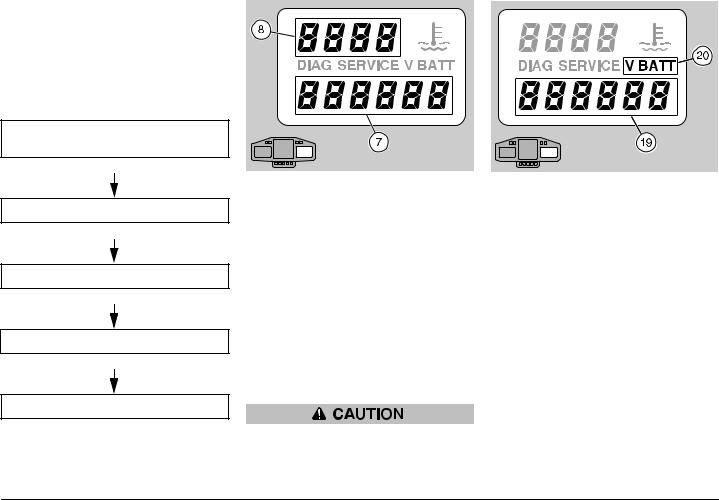
MULTIFUNCTION (RIGHT DISPLAY)
The right display (multifunction) includes the coolant temperature in °C (°F) (8) and the digital clock (7) as standard settings.
NOTE When the engine is cold, the writing "W" blinks.
By pressing the push button X, the following functions can be obtained in sequence:
Standard setting: Temperature in °C and digital clock
X
Battery voltage (V BATT)
X
Setting the hour
X
Setting the minutes
X
Setting °C or °F
STANDARD SETTING: COOLANT TEMPERATURE AND DIGITAL CLOCK
The coolant temperature value (8) is shown in the upper part of the right display. It is possible to switch from °C to °F and viceversa, see p. 24 (SETTING °C OR °F).
–When the temperature is below 35°C (95°F), the writing “W” (8) blinks on the right display.
–When the temperature is over 115°C (239°F), the value (8) blinks on the right display, even if a function different from the standard setting has been set.
–When the temperature is over 130°C (266°F), the writing “LLL” (8) appears on the right display.
If the writing “LLL” is displayed with a temperature below 130°C (266°F), there may be a failure of the electric circuit. In this case, contact an aprilia Official Dealer.
Thermometer range on the display: 35– 130°C (95–266 °F).
The digital clock (7) appears in the lower part of the right display. To set or modify hour and minutes, see p. 24 (SETTING THE HOUR) and (SETTING THE MINUTES).
BATTERY VOLTAGE - VBATT
If the push button Xis pressed once, the battery voltage expressed in volt (19) appears in the lower part of the right display, while the coolant temperature (8) is displayed in the upper part. The writing “V BATT” (20) is displayed. The recharge circuit functions correctly if at 4000 rpm the battery voltage with low beam on is included between 13 and 15 V.
use and maintenance RSV mille !- RSV mille R ! 23
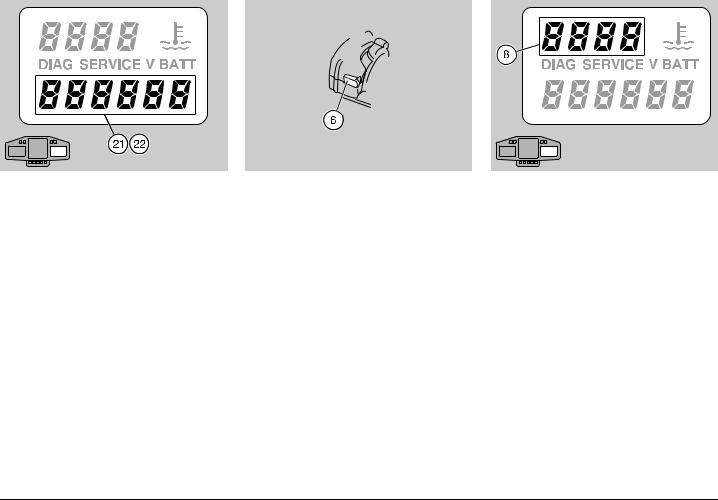
SETTING THE HOUR
When the push button X is pressed for the second time, the hour segments (21) start blinking in the lower part of the right display (digital clock).
To modify the hour setting, press the “LAP” push button (6) on the left part of the handlebar.
To confirm the hour setting, press the push button X.
SETTING THE MINUTES
When the push button X is pressed for the third time, the minute segments (22) start blinking in the lower part of the right display (digital clock).
To modify the minute setting, press the “LAP” push button (6) on the left part of the handlebar.
To confirm the minute setting, press the push button X.
SETTING °C OR °F
When the push button X is pressed for the fourth time, the segments of the coolant temperature in °C or °F (8) start blinking in the upper part of the display.
To modify from °C to °F setting, or vice versa, press the “LAP” push button (6) on the left part of the handlebar.
To confirm the setting, press the push button X.
24 use and maintenance RSV mille !- RSV mille R !
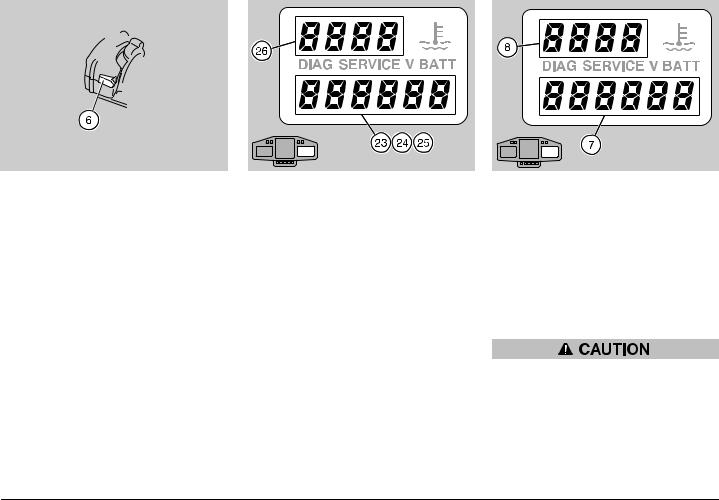
CHRONOMETER (RIGHT DISPLAY)
The chronometer makes it possible to measure the time per lap with the vehicle on a racetrack and to store the data, in such a way as to be able to consult them successively.
When the “CHRONOMETER” function has been selected, it is not possible to recall the following functions:
–maximum speed “V max”;
–average speed “AVS”;
–distance “trip 2”.
To operate the chronometer, press the
“LAP” push button (6) and, within seven seconds, the push button X.
To start timing, press the “LAP” push button (6) and release it immediately.
To store the time acquired, press the “LAP” push button (6).
The “LAP” push button (6) is not enabled for 10 seconds and the last time stored (23) is shown on the display.
After which, the chronometer with the current timing (24) is displayed, starting from ten seconds.
To display the first time stored (25), press the push button U.
To be able to see the stored times in se-
quence, press the “LAP” push button (6). The writings L1, L2, L3, L4, etc. (26) are displayed.
To start timing again, press the push button U.
NOTE It is possible to store max. 40 times, after which the “LAP” push button
(6) is not effective any longer.
To set the memory to zero, press the push button T and the “LAP” push button (6) at the same time for two seconds.
To leave the chronometer function, press the “LAP” push button (6) and the push
button X.
The coolant temperature (8) and the digital clock (7) appear on the right display (multifunction).
NOTE When the engine is cold, the writing "W" blinks.
DIAGNOSTICS
Whenever the ignition switch is turned to position “B”, the writing “EFI” is displayed for about three seconds.
If the writing “efi” is displayed during the normal operation of the engine, this means that the electronic unit has detected an anomaly.
In many cases, the engine keeps running with reduced performance levels; immediately contact an aprilia Official Dealer.
use and maintenance RSV mille !- RSV mille R ! 25
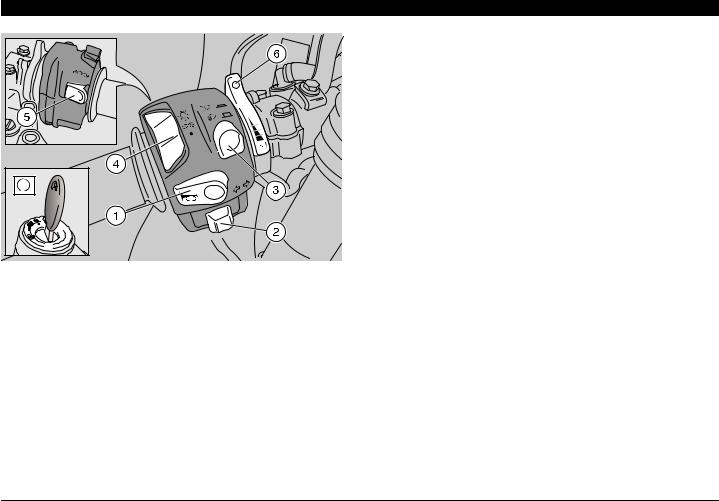
MAIN INDEPENDENT CONTROLS
CONTROLS ON THE LEFT PART OF THE HANDLEBAR
NOTE The electrical parts work only when the ignition switch is in position “B”.
1)HORN PUSH BUTTON (H)
The horn is activated when the push button is pressed.
2)DIRECTION INDICATOR SWITCH (G)
To indicate the turn to the left, move the switch to the left; to indicate the turn to the right, move the switch to the right.
To turn off the direction indicator, press the switch.
3)DIMMER SWITCH (Y- Z)
When the light switch is in position "I": if the dimmer switch is in position "Z", the high beam comes on; while if it is in position "Y", the low beam comes on.
3)DIMMER SWITCH (Y- Z) $
When it is in position “Y” the parking lights, the dashboard
light and the low beam are always on.
When it is in position “Z”, the high beam comes on.
4)LIGHT SWITCH (I- J- •) (not provided for $)
When the light switch is in position "•", the lights are off; when the switch is in position "J", the parking lights and the dashboard light are on; when the switch is in position "I", the parking lights, the dashboard light and the low beam are on.
The high beam can be operated by means of the dimmer switch.
5)HIGH BEAM SIGNALLER PUSH BUTTON (F)/LAP PUSH
BUTTON (multifunction)
NOTE For the setting of the functions, see p. 20 (MULTIFUNCTION COMPUTER).
This push button makes it possible to use the high beam signaller in case of danger or emergency, or displays the various preset functions on the right multifunction display:
–hour and minutes;
–coolant temperature (°C or °F);
–chronometer.
26 use and maintenance RSV mille !- RSV mille R !
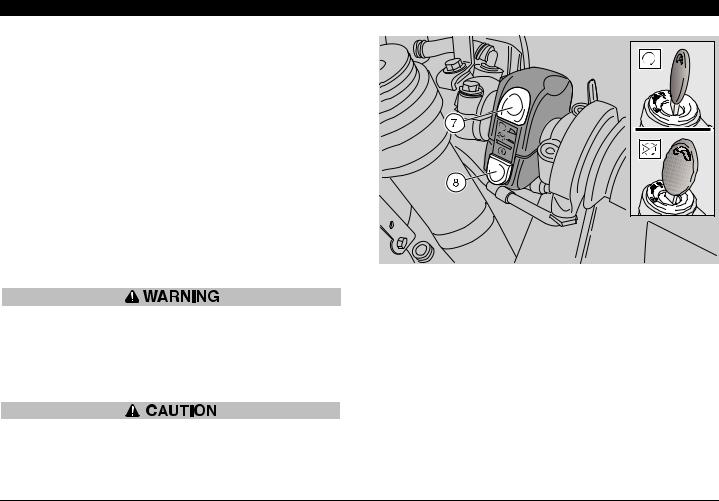
The high beam blinking is operated by pressing the push button, independently of the position of the light switch (I- J - •).
NOTE To disconnect the high beam blinking, release the push button.
6)COLD START LEVER (A)
The starter for the cold start of the engine is operated by rotating the lever “A” downwards.
To disconnect the starter, move the lever “A” to its initial position.
CONTROLS ON THE RIGHT PART OF THE HANDLEBAR
NOTE The electrical parts work only when the ignition switch is in position “B”.
7) ENGINE STOP SWITCH (LB- MC)
Do not operate the engine stop switch "LB- MC" in running conditions.
This is a safety or emergency switch.
When the switch is in position "L B", it is possible to start the engine; the engine can be stopped by moving the switch to position "MC".
With stopped engine and ignition switch in position "LB", the battery may discharge.
When the vehicle has come to rest, after stopping the engine, move the ignition switch to position “MC”.
8)START PUSH BUTTON (K)
When the start push button “K” is pressed, the starter makes the engine run. For the starting, see p. 50 (STARTING).
use and maintenance RSV mille !- RSV mille R ! 27
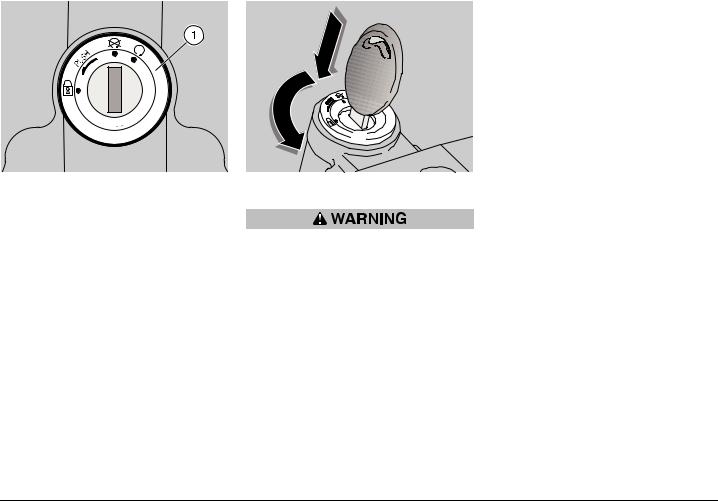
IGNITION SWITCH
The ignition switch (1) is positioned on the upper plate of the steering column.
NOTE The key operates the ignition switch/steering lock, the fuel tank lock and the glove/tool kit compartment lock.
Two keys are supplied together with the vehicle (one spare key).
NOTE Do not keep the spare key on the vehicle.
STEERING LOCK
Never turn the key to position “D” in running conditions, in order to avoid losing control of the vehicle.
OPERATION
To lock the steering:
Turn the handlebar completely leftwards.
Turn the key to position “C”.
Press the key and rotate it to position “D”.
Extract the key.
Position |
Function |
Key removal |
|
The steer- |
It is possible |
|
ing is |
to remove the |
D |
locked. It is |
key. |
neither pos- |
|
|
Steering |
sible to start |
|
the engine, |
|
|
lock |
|
|
nor to switch |
|
|
|
|
|
|
on the |
|
|
lights. |
|
|
|
|
|
Neither the |
It is possible |
C |
engine, nor |
to remove the |
the lights |
key. |
|
|
can be |
|
|
switched on. |
|
|
|
|
B |
The engine |
It is not possi- |
and the |
ble to remove |
|
lights can be |
the key. |
|
|
switched on. |
|
|
|
|
28 use and maintenance RSV mille !- RSV mille R !
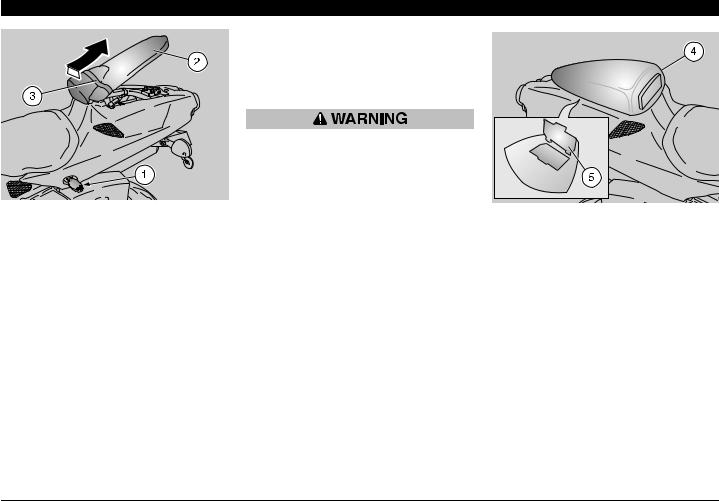
AUXILIARY EQUIPMENT
To lock the seat (2), proceed as follows:
Introduce its front part under the passenger grab strap (3).
Position the seat and press it, making the lock snap.
UNLOCKING/LOCKING THE PASSENGER SEAT
Position the vehicle on the stand, see p. 58 (POSITIONING THE VEHICLE ON THE STAND).
Introduce the key (1) in the seat lock.
Rotate the key (1) anticlockwise, lift and withdraw the seat (2) from behind.
NOTE Before lowering and locking the seat (2), make sure that you have not left the key in the glove/tool kit compartment.
Before leaving, make sure that the seat
(2) is properly locked.
NOTE For the 7 market, the # version can be used only in single-seater configuration. Therefore, vehicle outfit does not include the passenger's seat.
NOTE Glove/tool kit compartment cover
(4) can be used as an alternative to the passenger's seat (2).
To use the vehicle with the glove/tool kit compartment cover it is necessary to remove the passenger's seat as previously described.
See page 30 (UNLOCKING/LOCKING THE GLOVE/TOOL KIT COMPARTMENT COVER)for assembly instructions.
A useful compartment is available under the glove/tool kit compartment cover; to reach it, it is sufficient to release and remove the flap (5).
use and maintenance RSV mille !- RSV mille R ! 29

UNLOCKING/LOCKING THE GLOVE/TOOL KIT COMPARTMENT COVER
Position the vehicle on the stand, see p. 58 (POSITIONING THE VEHICLE ON THE STAND).
Introduce the key (1) in the lock.
Turn the key (1) anticlockwise, raise and withdraw the glove/tool kit compartment cover (2) from behind.
A useful compartment is available under the glove/tool kit compartment cover; to reach it, it is sufficient to release and remove the flap (3).
NOTE Before lowering and locking the glove/tool kit compartment cover (2), make sure that you have not left the key in the glove/tool kit compartment.
To lock the glove/tool kit compartment cover (2):
Introduce the lower front projections in the relevant recesses on the rear part of the fairing.
Position the glove/tool kit compartment cover in its seat and press it, so that the lock snaps.
Before leaving, make sure that the glove/tool kit compartment cover (2) is correctly locked.
30 use and maintenance RSV mille !- RSV mille R !
